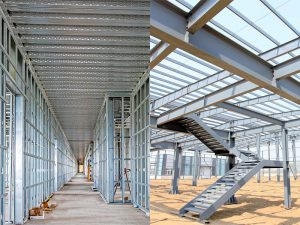There is an ancient adage that goes something like this: “Everyone wants a good price, outstanding quality, as well as speedy delivery; but you can only pick two of the three.” Things used to be the way they were described in the proverb, but things have progressed to the point where it is no longer relevant in the modern world. Customers who in the past may have utilized a pre-engineered building usually accepted lengthy lead times as a constant in the timeframe of their building project and instead settled for good costs and quality as their two available options. Nevertheless, a relatively recent concept that goes by the name of cold-formed steel buildings makes it possible for us to frequently meet our customers’ demands in terms of price, quality, and lead time. These cold formed buildings are constructed from cold-rolled steel.
Durability
Steel is an inorganic material; thus, it cannot decay, mold, or be eaten by termites as other organic materials may. Long-term durability is provided by a protective layer of zinc as well as other metallic coatings that are applied to the steel. According to research, this coating can persist for hundreds of years without showing any signs of disintegration.
Stability
When confronted with the structural stress and loads produced by significant wind and earthquake forces, steel behaves in a highly predictable manner because of its consistent chemistry. Steel can withstand these loads and stresses without deforming or cracking. Due to the inability of steel to absorb moisture, the use of steel in construction virtually eliminates the expansion and contraction of many other building materials, which is the primary cause of cracks, warps, as well as other imperfections in internal and external finishes.
Non-combustibility
Steel does not burn and does not help to increase the size or intensity of a fire. Steel will not contribute to a fire in any way. Because of this, it is quite simple to design cold-formed steel structures such that they satisfy the fire rating standards stipulated in the code. The loss history of combustible wood framing is worse than that of non-combustible materials, such as cold-formed steel frame, which is used in the construction of some buildings. Because of this, the premiums for many different types of cold formed buildings insurance tend to be lower, and the coverages extend further.
Superior ROI
When compared to more conventional building practices, the development of CFS buildings offers significant economic advantages. The advantages that CFS offers in terms of speed of construction, precision, and reduced labor costs can, considering the building design, result in overall installed costs that are lower than they would have been otherwise. In addition, CFS systems have the potential to provide a higher return on investment (ROI) for the entirety of a building’s useful life:
Constructing with CFS allows you a high degree of scalability.
CFS is perfect for use in large production and designs that need to be repeated.
Because of this, CFS helps to minimize the overall expenses of building upkeep over the long term.
Steel components do not warp or rot as wood components do, and they also do not require as much painting or staining as wood components do. Cold-formed steel can resist prolonged use and is better able to withstand the many dangers that are posed by Mother Nature, such as wind, rain, snow, lightning, and sometimes even seismic disturbances. Cold-formed steel is an excellent choice for construction projects. Steel also has the distinct virtue of not being able to catch fire, which makes it a safer material to use in environments where there is a high risk of fire. And despite the fact that termites and other insects, mold, and mildew pose a risk to wooden structures, steel is not in any danger from these elements. More sustainable is the same as more robust and resilient, and there aren’t many structures that are more sustainable than the well and well-installed structure made of light-gauge steel!
Work Loads Have Been Cut Back
Welding is typically required for the construction of the frames of traditional metal buildings. On the other hand, Cold Formed Buildings do not call for any sort of welding at any point during the process of either their production or their installation. Simply taking that one additional step makes a substantial difference. The majority of pre-engineered metal buildings call for a significant amount of notching and cutting to be done on site in order to adapt standard columns to the particulars of a given project. On the other hand, the majority of the components that are utilized in cold formed buildings are precisely created in the factory, which results in a reduction in the amount of labor required onsite.
Therefore, construction methods based on CFS that make use of cutting-edge automation technologies result in shorter times needed to construct a building, reduced costs overall, more adaptable design solutions, and improved building performance. In conjunction with other inherent properties of steel, such as non-combustibility, resistance to termites and mold, and dimensional stability, cold-formed steel framing (CFS) provides the framework for a robust and environmentally conscious building program.







